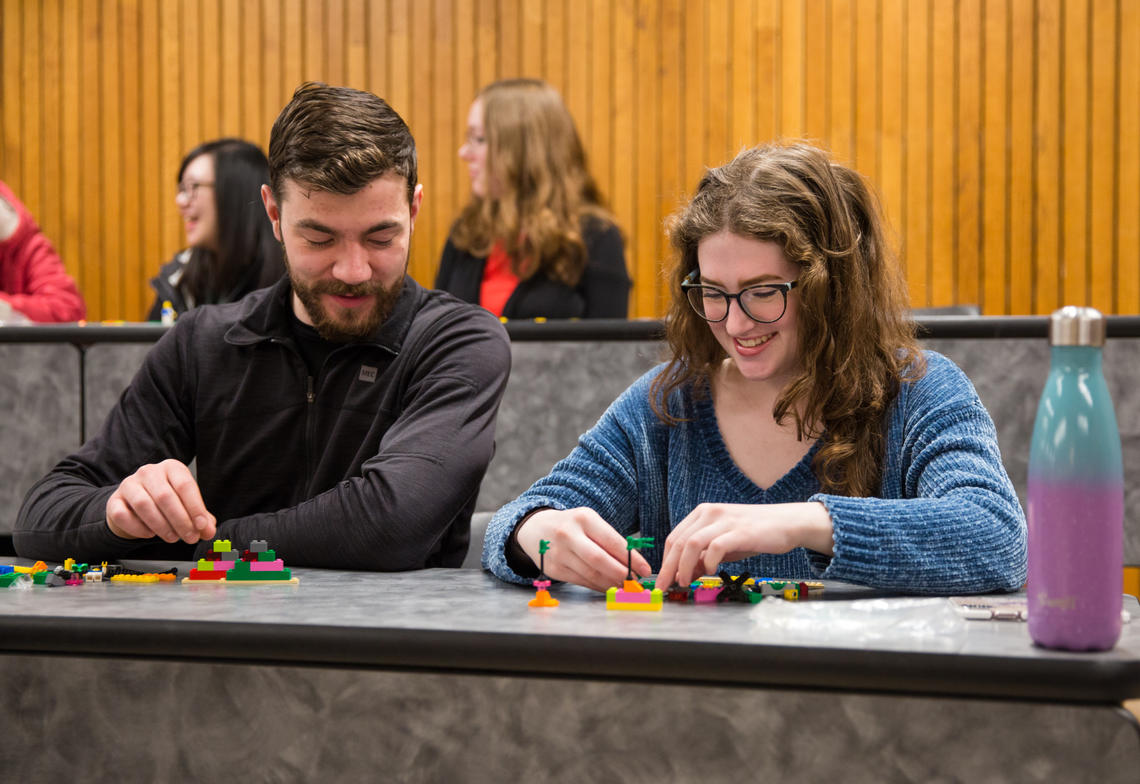Jan. 22, 2019
Students use Lego to turn difficult class into child's 'play'

As part of a pilot project that began in September, students use blocks to tell stories.
A simple toy is helping undergraduate students understand the strange, mathematical world of quantum chemistry.
“I thought it was a really cool idea to use Lego,” says Emily-Claire Docking, one of about 80 students taking Chem 373. “It worked really well and it was a lot of fun.”
As part of a pilot project that began in September, students have been using the plastic blocks in much the same way as is done by children — to playfully tell stories. “The students put the bricks together in their own way, and they make up their own metaphors for what the bricks could mean,” says instructor Dr. Belinda Heyne, PhD, an associate professor in the Department of Chemistry in the Faculty of Science.
‘Going to fail’
Although it’s a level or so down from the quantum mechanics of Schrodinger’s Cat fame, quantum chemistry is still perceived to be a difficult subject. “Students are coming to this lecture like, ‘Oh my God, this is the course where I am going to fail,’” says Heyne.
They must learn abstract equations that describe such things as how electrons form chemical bonds between atoms. Although the bonds bring together the molecules in the everyday objects people can see, touch or taste, reality behaves very differently at the unbelievably tiny, subatomic scale of an electron.
“Let's say you are shooting a gun,” says Heyne. “If you know the velocity and the angle, you can exactly see where the bullet is going. If you are thinking about your car keys, you know they are in your jacket pocket. They’re in a very precise location. But an electron’s location is not precise like that — it behaves like a wave, so its ‘location’ is spread out.”
Such uncertainty is part of things such as atomic orbitals, which by their nature cannot be observed experimentally. Unlike the orbit of the moon around the Earth, an orbital is something that mathematically describes the probability of finding an electron in any given area around an atom’s nucleus.
“There’s a lot of very abstract thought in quantum chemistry, and thinking about things that you can’t see and you can’t interact with,” says Docking. “And I'm not very good at math.”

Heyne says Lego can help you conceptualize or model abstract concepts, helping your understanding.
Mathematics used as tool
Heyne says students often have a particularly hard time understanding the concept behind an operator, which refers to a key part of the math of quantum chemistry. It can be used as a kind of tool, she says, pointing to the example of someone in the everyday world who is trying to figure out the length of a wall.
“You are going to take your ruler, you are going to measure the wall and you are going to obtain a number, which will correspond to the length,” she says.
“Now, in my course, we want to know what is the energy of an electron in an orbital, and what students have to do is use the operator. They have a really hard time understanding that the operator is a tool that is going to do a measurement, and that the output is going to be a number.
“They can only see the math and they don’t see that it’s actually a tool, but by using Lego, they can be creative. They can be like, ‘Oh, so it’s like a tool, and this is what my tool is going to be.’”
One student used the plastic blocks to build a figure of a person holding a scanner, which was being used to read the side of an airplane, says Heyne. “He got the flight number out of that, and so he really understood the concept,” she says.
‘You can make a new world’
Especially when scientific concepts are abstract and difficult to envision, “models are excellent tools for building our own understanding of science and helping us communicate these ideas to others,” says Dr. Wendy Benoit, PhD, associate dean of teaching, learning and student engagement at the Faculty of Science.
“Having Lego as a physical tool can spark discussion and get students to ask questions about normally inaccessible abstract ideas,” she says. “With students asking questions and enjoying their experiences with course content, we have a much greater chance of them taking ownership of the material and striving to learn more deeply.”
The intrinsic simplicity, yet versatility, of Lego allows it to express as many metaphors as students can imagine, says Heyne, adding that while the actual math stays the same for everyone, the way each person visualizes it can be as individual as they are.
“Lego can help you conceptualize or model abstract concepts, but another thing is that you might model it completely differently than someone else and that might help you get a better understanding,” she says. “You can be creative — you can make a new world.”
As part of the pilot project, a study will use student questionnaires to examine the effectiveness of Lego as a teaching method, says Heyne, adding the plastic blocks are used about once a week as part of what she calls “Lego Tuesday, like an ad on the radio.”
Compared to the previous year, “the students are doing much better, although I don’t really know if it’s really because of the methodology,” says Heyne, laughing. “I’m hoping so, but at least I think that now, they are coming to this class and it’s not like, ‘Oh, it’s a horrible, dry class.’ It’s a class where they can have fun because they play.”

The intrinsic simplicity, yet versatility, of Lego allows it to express as many metaphors.
